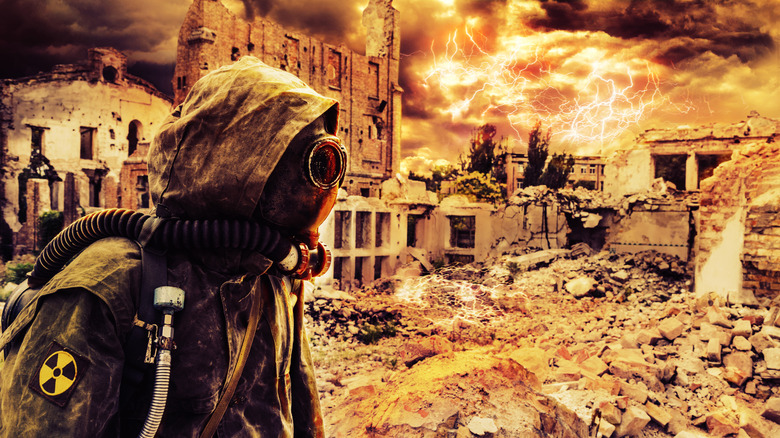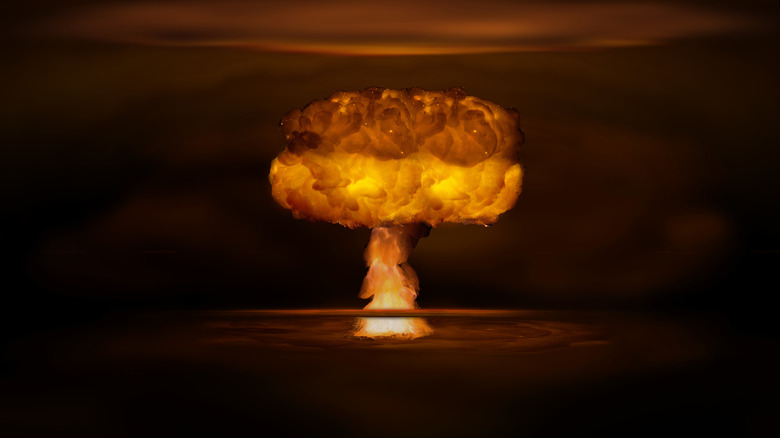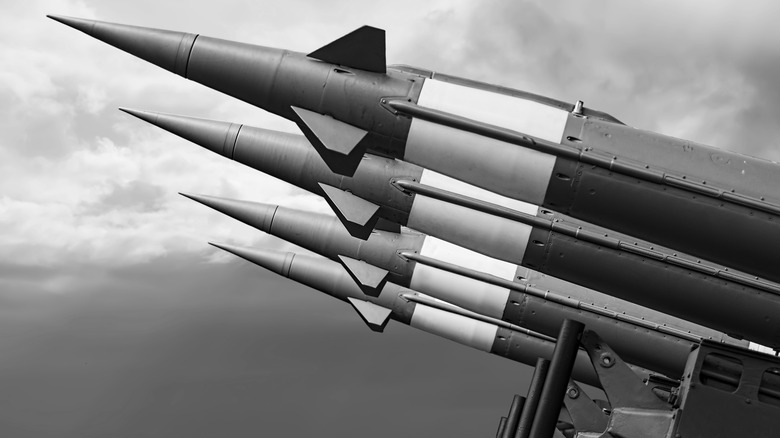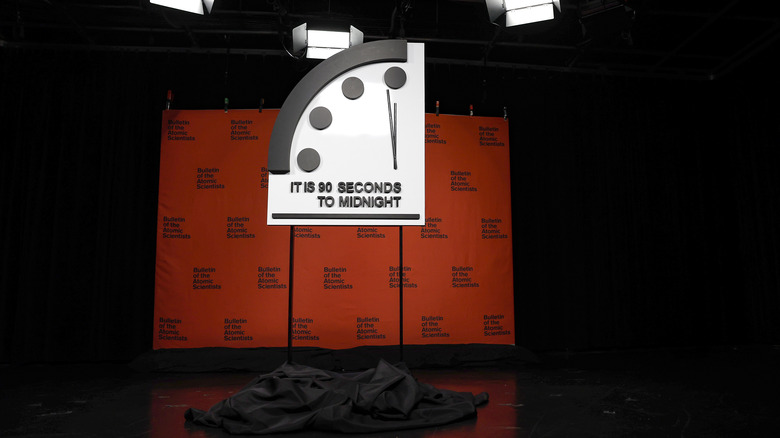What Is The Doomsday Clock, Created By The Bulletin Of Atomic Scientists?
On January 25, 2023, as CNN reported, a team of scientists set a clock. That may seem like an impossibly-trivial and mundane thing to report, but there's actually quite a bit more to it than that. The clock in question is the "Doomsday Clock," and the team of scientists represents the Bulletin of the Atomic Scientists, which created the clock back in 1947, and which is described by their website as "a select group of globally recognized leaders with a specific focus on nuclear risk, climate change, and disruptive technologies."
The Doomsday Clock is effectively a visual metaphor for how close humanity is to total extinction, whether due to climate change, nuclear annihilation, or some other threat. And this time, it was set to 90 seconds to midnight, the metaphorical point at which humanity will be made extinct. It represents the closest the clock has ever been to that point in its 70-plus-year history. "We are living in a time of unprecedented danger, and the Doomsday Clock time reflects that reality," said Rachel Bronson, president and CEO of the Bulletin, in a statement.
1947: A Metaphor Is Born
Back in 1947, according to the University of Chicago, the world was becoming acutely aware of the dangers of the atomic bomb. Just two years earlier, two of them had been used in war, at Hiroshima and Nagasaki, killing an estimated 100,000 people, according to Atomic Archive. Further, the United States and the Soviets were on the cusp of entering a nuclear arms race, as the Council on Foreign Relations explains.
Perhaps ironically, it was some of the people responsible for the Manhattan Project, the secret government program that laid the foundations for the eventual atomic bomb, that led to the creation of the Doomsday Clock. Not everyone who worked on the project knew that it was going to lead to a bomb used against civilians, and those who suspected or knew that it was "had misgivings," as the university describes it.
A couple of years after the bombs dropped, a team of scientists formed a group aimed at educating the public about the dangers of nuclear arms technology and other "man-made threats to our existence." The result of all of this was the Doomsday Clock, and when it debuted in 1947, it was set to seven minutes to midnight.
2007: Climate Change Enters the Mix
Climate science and atomic science are two completely different things. However, the two fields overlap in that each of them deals with matters that could spell the end of humanity. As such, in 2007, the Bulletin of Atomic Scientists officially added climate change to the list of risk factors expressed in the Doomsday Clock, as Eos reports. "Given that the impact of climate catastrophe, at the high end, can be equal to or worse than global thermonuclear war, you can consider that they are considered roughly equally important in setting the clock," said University of Oxford climate physicist Raymond Pierrehumbert.
The result of this is that there are now two major schools of thought pulling the hands of the metaphorical clock in metaphorical different directions. The nuclear threat may diminish, while the environmental threat increases, so what to do with the clock? As it turns out, that hasn't been an issue, as the threat of climate change has more or less remained static over the decades, Pierrehumbert explains, but the nuclear threat has increased and decreased here and there, resulting in the clock being moved. It also bears noting that the Bulletin considers other matters that are threats to humanity, such as disruptive technology, misinformation, and, according to the Bulletin's website, AI (artificial intelligence).
Moving The Hands
Since its inception, the hands of the Doomsday Clock have been moved 29 times, according to a timeline provided on the Bulletin's website. When it debuted in 1947, it was set to seven minutes until midnight. The next time it moved was in 1949 when it was moved to three minutes, following news that atomic explosions were being reported in the Soviet Union, according to a statement from the Bulletin. Over the next few decades, it moved around, sometimes staying where it was for several years, such as between 1953 (two minutes) and 1960 (when it was moved to seven minutes).
The furthest the clock was ever away from its metaphorical midnight was in 1991 when it was moved to 17 midnights to midnight, following the collapse of the Soviet Union ("A New Era," proclaimed the Bulletin). The goodwill of the collapse of the Soviet Union didn't last, however, and by 1994 it had been moved back to 14 minutes. In 2020, the clock was moved to 100 seconds to midnight — the closest it had ever been until that point — where it stayed in 2021 and 2022. In 2023, it was moved closer still, to 90 seconds until midnight.
2023: 90 Seconds Until Midnight
As mentioned previously, on January 25, 2023, according to CNN, the Bulletin moved the metaphorical clock's hands to indicate that it is 90 seconds until midnight, the closest it's ever been. The first sentence of the Bulletin's explanation for this year's movement makes it clear why: "largely (though not exclusively) because of the mounting dangers of the war in Ukraine."
Specifically, not only has the war largely destabilized Eastern Europe, but the war could evolve into a multi-national conflict, and at the heart of it is Russia, which is, at best, unpredictable. There's also the matter that Russia has made "thinly veiled," as the Bulletin describes it, threats of using nuclear weapons in this war.
Outside of the Russia/Ukraine matter, there's also the fact that we're no closer to winning our battle against climate change than we were a year ago. Biological threats remain, and the weaknesses of governments' ability to deal with them were made manifest in the wake of the COVID-19 pandemic.
Is There An Actual, Physical Doomsday Clock?
The Doomsday Clock was, is, and has always been a metaphor. There are no mechanisms within, ticking away the seconds, as in a real clock. "The Doomsday Clock is not a timepiece you can put on your bookshelf," notes Fortune. However, the same website notes that there is a physical iteration of the clock at the University of Chicago Keller Center on Manhattan's Upper East Side, and per Axios, a Doomsday Clock sits in the lobby of the Bulletin's offices at the University of Chicago.
Meanwhile, the time may have come to consider retiring the clock. Lawrence M. Krauss, a scientist who spent a few years on the team that considered the clock's movements, called it a publicity stunt, albeit a successful one. He notes that the clock is unscientific, its hands moved based on public policy and not science. He also rejects the notion that we're perilously close to the metaphorical midnight. "In reality, it is at about lunchtime," he said.





